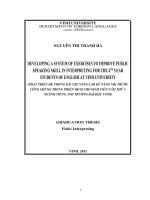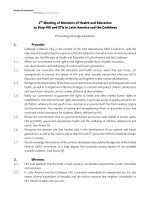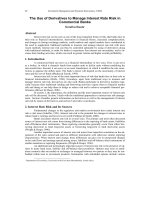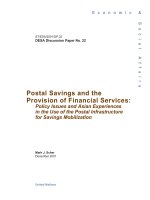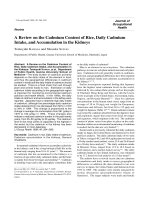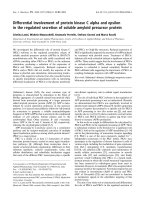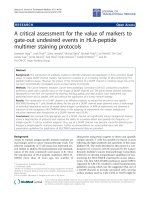Report of the Sub-Committee of the Central Board of Directors of Reserve Bank of India to Study Issues and Concerns in the MFI Sector doc
Bạn đang xem bản rút gọn của tài liệu. Xem và tải ngay bản đầy đủ của tài liệu tại đây (264.94 KB, 65 trang )
Report of the
Sub-Committee of the Central Board of
Directors
of Reserve Bank of India
to Study Issues and Concerns in the MFI Sector
RESERVE BANK OF INDIA
January 2011
1
1 Introduction
1.1 The Board of Directors of the Reserve Bank of India, at its meeting held on
October 15, 2010 formed a Sub-Committee of the Board to study issues
and concerns in the microfinance sector in so far as they related to the
entities regulated by the Bank.
1.2 The composition of the Sub-Committee was as under:-
Shri Y.H. Malegam – Chairman
Shri Kumar Mangalam Birla
Dr. K. C. Chakrabarty
Smt. Shashi Rajagopalan
Prof. U.R. Rao
Shri V. K. Sharma (Executive Director) – Member Secretary
1.3 The terms of reference of the Sub-Committee were as under:-
1. To review the definition of ‘microfinance’ and ‘Micro Finance
Institutions (MFIs)’ for the purpose of regulation of non-banking
finance companies (NBFCs) undertaking microfinance by the
Reserve Bank of India and make appropriate recommendations.
2. To examine the prevalent practices of MFIs in regard to interest
rates, lending and recovery practices to identify trends that
impinge on borrowers’ interests.
3. To delineate the objectives and scope of regulation of NBFCs
undertaking microfinance by the Reserve Bank and the regulatory
framework needed to achieve those objectives.
4. To examine and make appropriate recommendations in regard
to applicability of money lending legislation of the States and
other relevant laws to NBFCs/MFIs.
5. To examine the role that associations and bodies of MFIs could
play in enhancing transparency disclosure and best practices
6. To recommend a grievance redressal machinery that could be
put in place for ensuring adherence to the regulations
recommended at 3 above.
7. To examine the conditions under which loans to MFIs can be
classified as priority sector lending and make appropriate
recommendations.
2
8. To consider any other item that is relevant to the terms of
reference.
2
The Microfinance sector
2.1 Microfinance is an economic development tool whose objective is to
assist the poor to work their way out of poverty. It covers a range of
services which include, in addition to the provision of credit, many other
services such as savings, insurance, money transfers, counseling, etc.
2.2 For the purposes of this report, the Sub-Committee has confined itself to
only one aspect of Microfinance, namely, the provision of credit to low-
income groups.
2.3 The provision of credit to the Microfinance sector is based on the
following postulates:
a) It addresses the concerns of poverty alleviation by enabling the
poor to work their way out of poverty.
b) It provides credit to that section of society that is unable to obtain
credit at reasonable rates from traditional sources.
c) It enables women’s empowerment by routing credit directly to
women, thereby enhancing their status within their families, the
community and society at large.
d) Easy access to credit is more important for the poor than cheaper
credit which might involve lengthy bureaucratic procedures and
delays.
e) The poor are often not in a position to offer collateral to secure
the credit.
f) Given the imperfect market in which the sector operates and the
small size of individual loans, high transaction costs are
unavoidable. However, when communities set up their own
institutions, such as SHG federations and co-operatives the
transaction costs are lower.
g) Transaction costs, can be reduced through economies of scale.
However, increases in scale cannot be achieved, both for
individual operations and for the sector as a whole in the
absence of cost recovery and profit incentive.
3
2.4 Given the above considerations, the essential features of credit for
Microfinance which have evolved are as under:-
a) The borrowers are low-income groups.
b) The loans are for small amounts.
c) The loans are without collateral.
d) The loans are generally taken for income-generating activities,
although loans are also provided for consumption, housing and
other purposes.
e) The tenure of the loans is short.
f) The frequency of repayments is greater than for traditional
commercial loans.
2.5 The players in the Microfinance sector can be classified as falling into
three main groups
a) The SHG-Bank linkage Model accounting for about 58% of the
outstanding loan portfolio
b) Non-Banking Finance Companies accounting for about 34% of
the outstanding loan portfolio
c) Others including trusts, societies, etc, accounting for the balance
8% of the outstanding loan portfolio. Primary Agricultural Co-
operative Societies numbering 95,663, covering every village in
the country, with a combined membership of over 13 crores and
loans outstanding of over Rs.64, 044 crores as on 31.03.09 have a
much longer history and are under a different regulatory
framework. Thrift and credit co-operatives are scattered across
the country and there is no centralized information available
about them.
2.6 The SHG-Bank Linkage Model was pioneered by NABARD in 1992. Under
this model, women in a village are encouraged to form a Self help Group
(SHG) and members of the Group regularly contribute small savings to
the Group. These savings which form an ever growing nucleus are lent by
the group to members, and are later supplemented by loans provided
by banks for income-generating activities and other purposes for
sustainable livelihood promotion. The Group has weekly/monthly
meetings at which new savings come in, and recoveries are made from
members towards their loans from the SHGs, their federations, and banks.
4
NABARD provides grants, training and capacity building assistance to Self
Help Promoting Institutions (SHPI), which in turn act as facilitators/
intermediaries for the formation and credit linkage of the SHGs.
2.7 Under the NBFC model, NBFCs encourage villagers to form Joint Liability
Groups (JLG) and give loans to the individual members of the JLG. The
individual loans are jointly and severally guaranteed by the other
members of the Group. Many of the NBFCs operating this model started
off as non-profit entities providing micro-credit and other services to the
poor. However, as they found themselves unable to raise adequate
resources for a rapid growth of the activity, they converted themselves
into for-profit NBFCs. Others entered the field directly as for-profit NBFCs
seeing this as a viable business proposition. Significant amounts of private
equity funds have consequently been attracted to this sector.
3 The need for regulation
3.1 All NBFCs are currently regulated by Reserve Bank under Chapters III-B, III-
C and V of the Reserve Bank of India Act. There is, however, no separate
category created for NBFCs operating in the Microfinance sector.
3.2 The need for a separate category of NBFCs operating in the
Microfinance sector arises for a number of reasons.
3.3 First, the borrowers in the Microfinance sector represent a particularly
vulnerable section of society. They lack individual bargaining power,
have inadequate financial literacy and live in an environment which is
fragile and exposed to external shocks which they are ill-equipped to
absorb. They can, therefore, be easily exploited.
3.4 Second, NBFCs operating in the Microfinance sector not only compete
amongst themselves but also directly compete with the SHG-Bank
Linkage Programme. The practices they adopt could have an adverse
impact on the programme. In a representation made to the Sub-
Committee by the Government of Andhra Pradesh, it has been argued,
that the MFIs are riding “piggy-back” on the SHG infrastructure created
by the programme and that JLGs are being formed by poaching
members from existing SHGs. About 30% of MFI loans are purportedly in
5
Andhra Pradesh. The Microfinance in India- A State of Sector Report 2010
also says that there are many reports of SHGs splitting and becoming
JLGs to avail of loans from MFIs. The A.P. Government has also stated that
as the loans given by MFIs are of shorter duration than the loans given
under the programme, recoveries by SHGs are adversely affected and
loans given by the SHGs are being used to repay loans given by MFIs.
While we did not, as committee, examine each of these issues in depth,
the fact that these complaints have been made reinforces the need for
a separate and focused regulation.
3.5 Thirdly, credit to the Microfinance sector is an important plank in the
scheme for financial inclusion. A fair and adequate regulation of NBFCs
will encourage the growth of this sector while adequately protecting the
interests of the borrowers.
3.6 Fourth, over 75% of the finance obtained by NBFCs operating in this
sector is provided by banks and financial institutions including SIDBI. As at
31
st
March 2010, the aggregate amount outstanding in respect of loans
granted by banks and SIDBI to NBFCs operating in the Microfinance
sector amounted to Rs.13,800 crores. In addition, banks were holding
securitized paper issued by NBFCs for an amount of Rs.4200 crores. Banks
and Financial Institutions including SBIDBI also had made investments in
the equity of such NBFCs. Though this exposure may not be significant in
the context of the total assets of the banking system, it is increasing
rapidly.
3.7 Finally, given the need to encourage the growth of the Microfinance
sector and the vulnerable nature of the borrowers in the sector, there
may be a need to give special facilities or dispensation to NBFCs
operating in this sector, alongside an appropriate regulatory framework.
This will be facilitated if a separate category of NBFCs is created for this
purpose.
3.8 We would therefore recommend that a separate category be created for
NBFCs operating in the Microfinance sector, such NBFCs being
designated as NBFC-MFI.
6
4 Definition
4.1 Once a separate category of NBFC-MFI is created, it becomes necessary
to provide in the regulations a definition for such NBFCs. This definition
must incorporate the distinctive features of a NBFC-MFI.
4.2 The Sub-Committee therefore recommends that a NBFC-MFI may be
defined as
“A company (other than a company licensed under Section 25 of the
Companies Act, 1956) which provides financial services pre-dominantly
to low-income borrowers with loans of small amounts, for short-terms, on
unsecured basis, mainly for income-generating activities, with
repayment schedules which are more frequent than those normally
stipulated by commercial banks and which further conforms to the
regulations specified in that behalf”.
5 Regulations to be specified
5.1 A study of 9 large and 2 small NBFC-MFIs shows that loans constitute an
average of 95% of total assets (excluding cash and bank balances and
money market instruments). We may, therefore, accept that a NBFC pre-
dominantly provides financial services to the Microfinance sector if its
loans to the sector constitute not less than 90% of its total assets
(excluding cash and bank balances and money market instruments). It is
also necessary to specify that a NBFC which is not a NBFC-MFI shall not
be permitted to have loans to the Microfinance sector which exceed
10% of its total assets.
5.2 Most MFIs consider a low-income borrower as a borrower who belongs to
a household whose annual income does not exceed Rs.50,000/ This is a
reasonable definition and can be accepted.
5.3 a) Currently, most MFIs give individual loans which are between Rs.
10,000 and Rs. 15,000. However, some large NBFCs also give larger loans,
even in excess of Rs.50,000 for special purposes like micro-enterprises,
housing and education.
b) It is important to restrict the size of individual loans as larger loans
can lead to over-borrowing, diversion of funds and size of
7
repayment installments which are beyond the repayment
capacity of the borrower.
c) It is, therefore, suggested that the size of an individual loan should
be restricted to Rs.25,000. Further, to prevent over-borrowing, the
aggregate value of all outstanding loans of an individual
borrower should also be restricted to Rs. 25,000.
5.4 a) MFIs normally give loans which are repayable within 12 months
irrespective of the amount of the loan. However, the larger the
loan, the larger the amount of the repayment installment, and a
large installment may strain the repayment capacity of the
borrower and result in ever greening or multiple borrowing. At the
same time, if the repayment installment is too small, it would
leave cash with the borrower which could be directed to other
uses and not be available for repayment when repayment is
due.
b) There has, therefore, to be a linkage between the amount of the
loan and the tenure of the loan. It is, therefore, suggested that for
loans not exceeding Rs. 15,000, the tenure of the loan should not
be less than 12 months and for other loans the tenure should not
be less than 24 months. The borrower should however have the
right of prepayment in all cases without attracting penalty.
5.5 a) Low-income borrowers often do not have assets which they can
offer as collateral, and it is important to ensure that in the event of
default, the borrower does not lose possession of assets which s/he
may need for her/his continued existence.
b) It is, therefore, suggested that all loans should be without
collateral.
5.6 a) It is often argued that loans should not be restricted to income
generating activities but should also be given for other purposes
such as repayment of high-cost loans to moneylenders,
education, medical expenses, consumption smoothing,
acquisition of household assets, housing, emergencies, etc. A
recent study by Centre for Microfinance of borrowers in
Hyderabad indicates that Microfinance is useful in smoothening
8
consumption and relieving seasonal liquidity crises that visit poor
families and that it obviates the need for high-cost borrowing from
informal sources.
b) The need for loans for the above purposes cannot be denied. At
the same time there are powerful arguments why loans by NBFC-
MFIs should be confined to income-generating activities.
i. Firstly, the main objective of NBFC-MFIs should be to
enable borrowers, particularly women to work their way
out of poverty by undertaking activities which generate
additional income. This additional income, after
repayment of the loan and interest, should provide a
surplus which can augment the household income,
enable consumption smoothing and reduce dependence
on the moneylender.
ii. Secondly, if the loans are not used for repayment of high-
cost borrowing, but are used for consumption, they will in
fact add to the financial burden of the household as there
will be no additional source from which the loan and
interest thereon can be repaid.
iii. Thirdly, borrowing for non-income generating purposes
may tempt borrowers to borrow in excess of their
repayment capacity.
iv. Finally, if there is no identified source from which interest
and installment can be paid, the rate of delinquency will
increase. This additional cost will push interest rates
upwards and may even result in the use of more coercive
methods of recovery.
c) Therefore, a balance has to be struck between the benefits of
restricting loans only for income-generating purposes and
recognition of the needs of low-income groups for loans for other
purposes.
d) According to “Access to Finance in Andhra Pradesh, 2010,
CMF/IFMR, Chennai” the usage of loans given by JLGs and SHGs
is as under:
9
Sr.No. Particulars JLG% SHG%
i) Income generation 25.6 25.4
ii) Repayments of old
debt
25.4 20.4
iii) Health 10.9 18.6
iv) Home
improvement
22.1 13.0
v) Education 4.4 5.7
vi) Others 11.6 7.9
e) We would however suggest that not more than 25% of the loans
granted by MFIs should be for non-income generating purposes.
5.7 a) Currently, some MFIs recover loans by weekly installments while
other MFIs recover loans by monthly installments. The rules made
under the Ordinance issued by the Andhra Pradesh Government
specify that recovery should be made only by monthly
installments.
b) In a representation made by the Government of Andhra Pradesh
to the Sub-Committee it has been argued that borrowers often
have uncertain levels of income flows and they are put to great
hardship to mobilize, accumulate and service a weekly
repayment commitment. It has also been stated by some MFIs
that they are able to reduce costs by moving from a weekly
system of repayment to a monthly system of repayment.
c) On the other hand, others have argued that some income-
generating activities provide a constant flow of cash and leaving
idle cash in the hands of borrowers increases the risk that the cash
may be diverted to purposes other than repayment of loans. A
weekly repayment schedule also means that the effective interest
can be reduced. However, N. Srinivasan in the 2010 Microfinance
India Report argues that there is enough evidence to suggest that
repayment rates do not materially suffer if the repayments are set
at fortnightly or monthly intervals.
d) In our opinion, each purpose for which a loan is used would
generate its own pattern of cash flows. Therefore, the repayment
pattern should not be rigid but should be so designed as to be
10
most suitable to the borrower’s circumstances. We would,
therefore, suggest that while MFIs should be encouraged to move
to a monthly repayment model, freedom should be given to the
MFI to fix a pattern of repayment which can be weekly, fortnightly
or monthly depending upon the nature of the loan. The choice of
a weekly, fortnightly or monthly repayment schedule should be
left to the borrower to suit his/her individual circumstances.
5.8 We have observed that some MFIs operate not merely as providers of
credit but also provide other services to the borrowers and others. These
services include acting as insurance agents, acting as agents for the
suppliers of mobile phones and telecom services, acting as agents for
the sale of household products, providing agricultural advisory services
etc. While these service can profitably be provided by MFIs along with
the supply of credit, there is a risk that given the vulnerable nature of the
borrower and his/her inadequate negotiating power, an element of
compulsion may creep in unless the provision of these services is
regulated. It is, therefore, necessary that the regulator limit the nature of
services which can be provided, as also the income which can be
generated from such services, the latter as a percentage of the total
income of the MFIs.
5.9 We would, therefore, recommend that a NBFC classified as a NBFC-MFI
should satisfy the following conditions:
a) Not less than 90% of its total assets (other than cash and bank
balances and money market instruments) are in the nature of
“qualifying assets.”
b) For the purpose of (a) above, a “qualifying asset” shall mean a
loan which satisfies the following criteria:-
i. the loan is given to a borrower who is a member of a
household whose annual income does not exceed Rs.
50,000;
ii. the amount of the loan does not exceed Rs. 25,000 and
the total outstanding indebtedness of the borrower
including this loan also does not exceed Rs. 25,000;
iii. the tenure of the loan is not less than 12 months where the
loan amount does not exceed Rs. 15,000 and 24 months in
11
other cases with a right to the borrower of prepayment
without penalty in all cases;
iv. the loan is without collateral;
v. the aggregate amount of loans given for income
generation purposes is not less than 75% of the total loans
given by the MFIs;
vi. the loan is repayable by weekly, fortnightly or monthly
installments at the choice of the borrower.
c) The income it derives from other services is in accordance with
the regulation specified in that behalf.
5.10 We would also recommend that a NBFC which does not qualify as a
NBFC-MFI should not be permitted to give loans to the microfinance
sector, which in the aggregate exceed 10% of its total assets.
6 Areas of Concern
The advent of MFIs in the Microfinance sector appears to have resulted in
a significant increase in reach and the credit made available to the
sector. Between 31
st
March 2007 and 31
st
March 2010, the number of
outstanding loan accounts serviced by MFIs is reported to have
increased from 10.04 million to 26.7 million and outstanding loans from
about Rs. 3800 crores to Rs. 18,344 crores. While this growth is impressive,
a number of studies both in India and abroad have questioned whether
growth alone is effective in addressing poverty and what the adverse
consequences of a too rapid growth might be. In particular, in the
Indian context, specific areas of concern have been identified: These
are:
a) unjustified high rates of interest
b) lack of transparency in interest rates and other charges.
c) multiple lending
d) upfront collection of security deposits
e) over-borrowing
f) ghost borrowers
g) coercive methods of recovery
7 Pricing of Interest
12
7.1 There is universal agreement that the pricing of interest charges and
other terms and conditions should be affordable to clients and at the
same time sustainable for MFIs.
7.2 The difficulty in maintaining a balance between the two arises because
the costs of credit delivery are relatively flat, that is, the delivery cost per
loan remains more or less the same, irrespective of the size of the loan,
whereas the income generated by the loan varies with its size. Therefore,
when a uniform rate of interest is used, larger loans will yield a profit while
smaller loans will show a loss. In the circumstances the options before a
regulator are limited.
7.3 Given the vulnerable nature of the borrowers, it becomes necessary to
impose some form of interest rate control to prevent exploitation. The
easiest and simplest form of control would be an interest rate cap but this
has its own drawbacks, as it could result in MFIs not providing services
where the loss is unsustainable, or the mix of services being skewed in
favour of larger loans. Moreover, it would be unfair to the MFIs when cost
of funds is volatile and forms a large part of the interest cap. However, to
prevent exploitation in individual cases, a ceiling on the rate of interest
charged on individual loans is desirable.
7.4 Another system is to have a margin cap which provides a cap on the
difference between the amount charged to the borrower and the cost
of funds to the MFI. While this, too, suffers from the drawbacks of an
interest cap, it is fairer to the MFI since it is not exposed to the risk of
volatility of cost of funds. It also recognizes that the cost of funds can vary
between different MFIs. We would, therefore, suggest that such a cap be
mandated.
7.5 For the purpose of determining what would be an appropriate margin
cap, we have examined the financials for the year ended 31
st
March
2010 of nine large MFIs which collectively account for 70.4% of the clients,
and 63.6% of the loan portfolio of Microfinance provided by all MFIs. We
also examined the financials for the same year of two smaller MFIs. The
results of that analysis are as under:-
13
a) For the larger MFIs the effective interest rate calculated on the
mean of the outstanding loan portfolio as at 31
st
March 2009 and
31
st
March 2010 ranged between 31.02% and 50.53% with an
average of 36.79%. For the smaller MFIs the average was 28.73%.
b) For the larger MFIs, the average cost of borrowings calculated on
the mean of the borrowings as at 31
st
March 2009 and 31
st
March
2010 ranged between 10.10% and 12.73% with an average of
11.78%. For the smaller MFIs the average cost was 11.71%
c) For the larger MFIs, the average cost of borrowings calculated on
the mean of the outstanding loan portfolio as at 31
st
March 2009
and 31
st
March 2010 ranged between 8.08% and 17.72% with an
average of 13.37% For the smaller MFIs it was 11.94%
d) For the larger MFIs, the staff cost as a percentage of the mean
outstanding loan portfolio as at 31
st
March 2009 and 31
st
March
2010, ranged between 5.94% and 14.27% with an average of
8.00%. For the smaller MFIs it was 4.46%
e) For the larger MFIs, the overheads (other than staff costs) as a
percentage of the mean outstanding loan portfolio as at 31
st
March 2009 and 31
st
March 2010, ranged between 2.46% and
8.87% with an average of 5.72%. For the smaller MFIs it was 3.63%.
f) For the larger MFIs, the provision for loan losses as a percentage of
the mean outstanding loan portfolio as at 31
st
March 2009 and
31
st
March 2010 ranged between 0.09% and 7.23% with an
average of 1.85%. For the smaller MFIs it was 1.07%.
g) For the larger MFIs, the profit before tax as a percentage of the
mean outstanding loan portfolio as at 31
st
March 2009 and 31
st
March 2010 ranged between 4.66% and 17.02% with an average
of 10.94%. For the smaller MFIs it was 9.40%.
h) For the larger MFIs, the debt/equity ratio, as at 31
st
March 2010
ranged between 2.24 and 7.32 with an average of 4.92. For the
smaller MFIs it was 5.61. If we assume a capital adequacy of 15%,
the resultant ratio would be 5.67.
7.6 a) In considering the staff and overhead costs, three factors need to
be noted:
i. While the cost of the field staff may be largely variable
with the size of the loan portfolio, the cost of the other
14
overheads may not vary in the same proportion.
Therefore, with increase in scale, the cost as a percentage
of the outstanding loan portfolio should decline in the
future.
ii. The last few years have witnessed a very rapid growth in
the operations of the MFIs. Thus, in 2009-10 alone, the
outstanding loan portfolio of MFIs grew by 56%. To achieve
this growth, there has been a rapid expansion in the
branch network and development costs have been
incurred before the branches broke even. This
development cost is included in the staff and overhead
costs. If these are excluded, the costs as a percentage of
the mean outstanding loan portfolio would be lower.
iii. Several MFIs have assigned/ecuritized a significant
portion of their portfolio. Therefore, while the size of the
portfolio is reduced, the costs remain the same as the MFIs
continue to operate as agent for collection for the
purchasers of the securitized paper. Consequently, if the
rates are to be calculated on the gross portfolio, both the
rate of interest on lending as also the cost percentage
would be lower.
b) The factors referred to in (a) (ii) and (a) (iii) above may partly
account for the fact that the study referred to in para 7.5 above,
shows that the overhead costs as a percentage of outstanding
loans is higher in the case of larger MFIs as compared to smaller
MFIs.
7.7 Based on the above study, we have attempted a normative cost
structure which can form the basis for a mandated margin cap as under:
15
% of Loan
Portfolio
(a) Staff Costs (say) 5.00
(b) Overheads (other than staff costs) say 3.00
(c) Provision for loan losses, say 1.00
Sub-total 9.00
(d) Return on Equity (say):
15% post tax i.e. 22.6107% pre-tax on
15% of Loan Portfolio
3.39
Total internal cost 12.39
(e) Cost of Funds (say)
12% on borrowings i.e. 85% of 12% on
Loan Portfolio
10.20
Total of internal and external costs 22.59
Rounded off to 22.00
7.8 It may, therefore, be mandated that the margin cap should be 10% over
the cost of funds for the larger MFIs i.e. those with a loan portfolio
exceeding Rs. 100 crores and 12% over the cost of funds for the smaller
MFIs i.e. those with a loan portfolio not exceeding Rs. 100 crores. This cap
will be calculated on the average outstanding loan portfolio. While this
margin cap may be considered slightly low in the context of the present
cost structure, it can be justified on the following grounds:-
a) There is no reason why the cost of development and expansion
included in the present costs should be borne by current
borrowers.
b) As the size of the operations increase, there should be greater
economies of scale and consequent reduction in costs in the
future.
c) In the last few years, not only has the growth of MFIs been
financed out of interest charged to borrowers but they have also
made profits which are in excess of what can be considered as
reasonable, given the vulnerable nature of the borrowers. They,
therefore, have the capacity to absorb these higher costs till the
growth rates stabilize and they achieve the desired scale of
operations.
16
7.9 The margin cap must be considered on an aggregate level and not as
applicable to individual loans. The MFIs must be given the freedom to
devise individual products and price them differently as also apply
different rates in different regions so long as the aggregate margin cap is
maintained. This will also facilitate monitoring by the regulator on the
basis of the Annual Financial Statements. If the regulator finds on
examination of the Annual Financial Statements that the average margin
has exceeded the “margin cap” the regulator can take such action as is
considered necessary. Several options are available. For example,
a) The MFI may be allowed to keep the excess income apart and
adjust this in determining the interest rate structure in the
succeeding year
b) The regulator can create a Borrower Protection Fund and the MFI
may be asked to transfer the excess income to the Fund. The
Fund can be used for such purposes such as financial literacy,
etc.
c) Penalty could be imposed on the MFI.
d) Access to priority sector loans may be suspended for a period of
time during which commercial loans could still be available to the
MFI to keep its business going.
7.10 However, in addition to the overall margin cap, there should be a cap of
24% on the individual loans.
7.11 We would, therefore, recommend that there should be a “margin cap” of
10% in respect of MFIs which have an outstanding loan portfolio at the
beginning of the year of Rs. 100 crores and a “margin cap” of 12% in
respect of MFIs which have an outstanding loan portfolio at the beginning
of the year of an amount not exceeding Rs. 100 crores. There should also
be a cap of 24% on individual loans.
8
Transparency in Interest Charges
8.1 MFIs generally levy a base interest charge calculated on the gross value
of the loan. In addition, they often recover a variety of other charges in
the form of an upfront registration or enrolment fee, loan protection fee,
etc. They also recover an insurance premium. It is important in the interest
of transparency that all stake-holders in the industry including borrowers,
17
lenders, regulators, etc. should have a better understanding of
comparative pricing by different MFIs. This requires the use of a common
format.
8.2 It is, therefore, suggested that MFIs should levy only two charges apart
from the insurance premium. These two charges should consist of an
upfront fee towards the processing of the loan which should not exceed
1% of the gross loan amount, and an interest charge.
8.3 To promote transparency and to make comparisons possible, the
borrower must know what is the effective interest rate on the loan which
s/he takes as also the other terms like repayment terms, etc. S/he should,
therefore, be given a loan card which records all these terms and which
is in the local language which s/he can understand. The card should be
used to record acknowledgements for each installment paid by the
borrower and the final discharge, duly authenticated by the lender, as
also sufficient details to identify the borrower as also the SHG/JLG to
which s/he belongs. It is also necessary that the effective interest rate
charged by the MFI is prominently displayed in its offices and in literature
issued by it and on its website.
8.4 The purpose of the insurance premium is to protect the MFI in the unlikely
event of the death of the borrower during the pendency of the loan.
Insurance to serve this purpose may be mandatory but beyond this
purpose should be optional. The premium should also be recovered as a
part of the loan repayment installment and not upfront and there should
be regulations for the proper disposal of the policy proceeds in the event
of the death of the borrower or maturity of the policy or for its assignment
on the settlement of the loan. We have also noticed that some MFIs levy
an insurance administration charge. We see no reason why such a
charge should be levied. MFIs should recover only the actual cost of
insurance.
8.5 We have observed that some MFIs recover a security deposit in cash
from the borrowers. We are informed that no interest is paid on this
deposit. As this deposit is recovered up front from the amount of the
loan, this amounts to charging interest on the gross value of the loan
18
when only the net amount is disbursed. The practice of security deposit,
therefore, distorts the interest rate structure and should be discontinued.
Further, the acceptance of such deposit is not permissible by the RBI Act.
8.6 Transparency and comparability would be considerately enhanced if
MFIs use a standard form of loan agreement.
8.7 We would, therefore, recommend that:-
a) There should be only three components in the pricing of the loan,
namely (i) a processing fee, not exceeding 1% of the gross loan
amount (ii) the interest charge and (iii) the insurance premium.
b) Only the actual cost of insurance should be recovered and no
administrative charges should be levied.
c) Every MFI should provide to the borrower a loan card which (i)
shows the effective rate of interest (ii) the other terms and
conditions attached to the loan (iii) information which adequately
identifies the borrower and (iv) acknowledgements by the MFI of
payments of installments received and the final discharge. The
Card should show this information in the local language
understood by the borrower.
d) The effective rate of interest charged by the MFI should be
prominently displayed in all its offices and in the literature issued
by it and on its website.
e) There should be adequate regulations regarding the manner in
which insurance premium is computed and collected and policy
proceeds disposed off.
f) There should not be any recovery of security deposit. Security
deposits already collected should be returned.
g) There should be a standard form of loan agreement.
9
Multiple-lending, Over-borrowing and Ghost-borrowers
9.1 The problems connected with multiple-lending, over-borrowing and
ghost-borrowers are interlinked and can be considered collectively.
There is considerable evidence that these practices are widely prevalent
and various reasons have been advanced for the same.
19
9.2 It has been suggested that with the development of active competition
between MFIs there has been a deluge of loan funds available to
borrowers which has fuelled excessive borrowing and the emergence of
undesirable practices. It is also claimed that the emergence of ring
leaders as key intermediaries between MFIs and potential customers has
distorted market discipline and good lending practices. There are reports
that ghost loans have become epidemic in some states. Finally, it is
believed that in consequence of over-borrowing, default rates have
been climbing in some locations but these have not been disclosed
because of ever-greening and multiple lending.
9.3 There can be several other reasons for multiple-lending and over-
borrowing. However, three major reasons may be noted.
a) The loans are given for income-generation but often there is
inadequate time given to the borrower between the grant of the
loan and the commencement of the repayment schedule. This
gives her/him insufficient time to make the institutional
arrangements necessary to be in a position to generate income.
In the absence of such a period of moratorium, it is likely that the
first few installments, particularly when the repayment is weekly,
would be paid out of the loan itself, thus reducing the amount
available for investment or paid out of additional borrowing. It is,
therefore, suggested that borrowers should be given a
reasonable period of moratorium between the disbursement of
the loan and the commencement of repayment. This period
should not be less than the frequency of repayment. Thus, a loan
repayable weekly would have a moratorium period of not less
than one week while a loan repayable monthly would have a
moratorium period of not less than one month.
b) MFIs often use existing SHGs as the target to obtain new
borrowers. This not only increases profit but also reduces their
transaction costs. These borrowers are, therefore, tempted to take
additional loans beyond their repayment capacity.
9.4 Many of the above adverse features would be minimized if borrowers are
allowed to become members of only one SHG/JLG and also if MFIs are
20
not allowed to give loans to individuals except as members of a JLG.
Such a regulation would have two advantages namely,
a) Multiple lending and over-borrowing can be avoided as the total
loans given to an individual can be more easily ascertained and
b) The risk is shared by other members of the JLG who can impose
some peer pressure against over-borrowing.
9.5 Over borrowing can also be reduced if not more than two MFIs lend to
the same borrower.
9.6 It is also necessary to provide that if a MFI gives an additional loan to a
borrower who already has an outstanding loan from a SHG/MFI, whereby
the prescribed aggregate borrowing limit is exceeded or gives an
additional loan when existing outstanding loans have been given by two
MFIs, then recovery of the additional loan shall be deferred till the earlier
loans are fully repaid.
9.7 We would, therefore, recommend that:-
a) MFIs should lend to an individual borrower only as a member of a
JLG and should have the responsibility of ensuring that the
borrower is not a member of another JLG.
b) a borrower cannot be a member of more than one SHG/JLG.
c) not more than two MFIs should lend to the same borrower.
d) there must be a minimum period of moratorium between the
grant of the loan and the commencement of its repayment.
e) recovery of loan given in violation of the regulations should be
deferred till all prior existing loans are fully repaid.
9.8 Ghost borrowers generally arise in two sets of circumstances:-
a) when the borrower on record is a benami for the real borrower
and
b) when fictitious loans are recorded in the books.
9.9 The first type of Ghost Borrower is often used as a device for multiple
lending or over- borrowing. This can be cured only by a better discipline in
the system of identification and data base of borrowers and better follow-
up by the field worker.
21
9.10 The second type of Ghost Borrower can pose a much greater systemic
problem as it would create fictitious assets and is often used to record
fictitious repayments and thus hide the actual level of delinquencies.
9.11 One of the ways by which the problem of Ghost Borrowers can be
minimized would be by better control in the structuring and disbursement
of loans. These functions should not be entrusted to a single individual but
should need the collective action of more than one individual and should
be done at a central location. In addition, there should be closer
supervision of the disbursement function.
9.12 We would, therefore, recommend that
all sanctioning and disbursement of loans should be done only at a
central location and more than one individual should be involved in this
function. In addition, there should be close supervision of the
disbursement function.
10 Credit information Bureau
10.1 An essential element in the prevention of multiple-lending and over-
borrowing is the availability of information to the MFI of the existing
outstanding loan of a potential borrower. This is not possible unless a
Credit Information Bureau is established expeditiously.
10.2 The function of the Bureau should not be to determine the credit
worthiness of the borrowers. Rather, it should provide a data base to
capture all the outstanding loans to individual borrowers as also the
composition of existing SHGs and JLGs. When more than one bureau
discharges the role, adequate co-ordination between the bureaus will
need to be established.
10.3 Micro Finance Institution Network (MFIN) formed in November 2009 is an
industry association of MFIs which claims it has 44 members (with another
5 in pipeline) who collectively constitute 80% of the MFI business. Similarly
Sa-Dhan is an association of community development finance institutions
which also includes MFIs within its membership. Both institutions have a
Code of Conduct for their members. Both institutions have represented
22
to us that they are actively working with a Credit Information Bureau to
build up a system whereby MFIs can report to the Bureau the status of all
loans granted by them. Once such a Bureau starts functioning there is no
reason why multiple lending and over borrowing cannot be controlled.
10.4 The issue is what can be done until such a Bureau starts functioning. We
believe that until that time, MFIs should have the responsibility to make
reasonable enquiries to find out a prospective borrower’s outstanding
loans. Given the fact that most loans are given to borrowers in a village
and the fact that MFIs have field staff who have sources of information,
this should not be too onerous a task.
10.5 We would therefore recommend that
a) One or more Credit Information Bureaus be established and be
operational as soon as possible and all MFIs be required to
become members of such bureau.
b) In the meantime, the responsibility to obtain information from
potential borrowers regarding existing borrowings should be on
the MFI.
11 Coercive Methods of Recovery
11.1 There are reports that MFIs or their employees and agents have used
coercive methods of recovery and similar complaints have been made
by many of the organisations which have made representations to us.
While we did not seek any specific evidence about the extent of this
malpractice, the very fact that such claims are widely made makes it
obvious that the matter needs attention.
11.2 Coercive methods of recovery are, to some extent, linked with the issues
of multiple lending and over-lending. If these issues are adequately
addressed, the need for coercive methods of recovery would also get
significantly reduced.
11.3 The primary responsibility for the prevention of coercive methods of
recovery must rest with the MFIs. They have to accept responsibility for
the good conduct of their employees and if employees or outsourced
workers misbehave or resort to coercive methods of recovery, severe
23
penalties must be levied on the MFIs and their management. If this is
done, the managements of MFIs, in their own interest, will establish a
proper Code of Conduct for field staff and make greater investments in
the training and supervision of the field staff to prevent such occurrences.
11.4 Coercive methods of recovery also surface when the growth of the MFI is
faster than its ability to recruit the required staff of the right quality and to
provide them adequate training. It also surfaces when the systems of
control and inspection are inadequate. These are areas which will have
to be monitored by the regulator.
11.5 It has been suggested that coercive methods of recovery have been
encouraged by the practice of enforcing recovery by recovery agents
visiting the residence of the borrowers. The Andhra Pradesh Micro
Finance Institutions (Regulations of Money Lending) Act 2010 drafted by
the State Government includes a list of actions which constitute
“coercive action”. This includes “frequenting the house or other place
where such person resides or works, or carries on business, or happens to
be”. It also provides that “all tranches of repayment shall be made by
the SHG or its members at the office of the Gram Panchayat or at a
public place designated by the District Collectors only”.
11.6 We agree that recovery should not be made at the borrower’s place of
residence or business as that may encourage coercive methods of
recovery. At the same time we believe if the designated place of
recovery is the Gram Panchayat office or any other place distant from
the borrowers’ place of residence or work s/he would need to incur
avoidable time and cost. There are advantages in requiring recovery
from the group as a whole at a central location and this may be
specified by the MFI. This will ensure that the privacy of the group is
respected and that there is sufficient peer pressure on the borrower to
make the repayments.
11.7 It is interesting in this context to consider the experience of banks which
in respect of their retail portfolio had in the past faced similar problems of
coercive recovery. We believe this problem was significantly reduced by
the following measures:-
24
a) The size of their portfolio was reduced to the levels which they
could adequately control.
b) The use of out-sourced recovery agents was reduced and more
of their own employees were used for recovery particularly in
sensitive areas.
c) The types of products were examined and recovery methods
were fine tuned to recognize the variances in these products.
d) Training and supervision were greatly enhanced
e) Compensation methods for staff were reviewed and greater
emphasis was given to areas of service and client satisfaction
than merely the rate of recovery.
Some of these methods can be profitably used by MFIs.
11.8 It is also necessary that MFIs are sensitive to the reasons for a borrower’s
default. If this default is of a temporary nature or willful, the MFI may
enforce recovery from other members of the Group but if there are
external factors beyond the control of the borrower, some time for
recovery may need to be given.
11.9 A key component in the prevention of coercive recovery is an adequate
grievance redressal procedure. It is necessary that there should be a
grievance redressal system established by each MFI and for this to be
made known to the borrower in the literature issued, by display in its
offices, by posting on the website and by prominent inclusion in the Loan
Card given to the borrower. In addition, it is necessary that there should
be independent authorities established to whom the borrower can make
reference.
11.10 It has been represented to us that Sa-Dhan has at the national level an
Ethical Grievance Redressal Committee. Similarly MFIN has an
Enforcement Committee for dealing with Code of Conduct violations.
While these initiatives are commendable it is necessary that there should
be an institution like the Ombudsman to whom aggrieved borrowers can
make reference. These Ombudsmen should be located within easy
reach of the borrowers.
